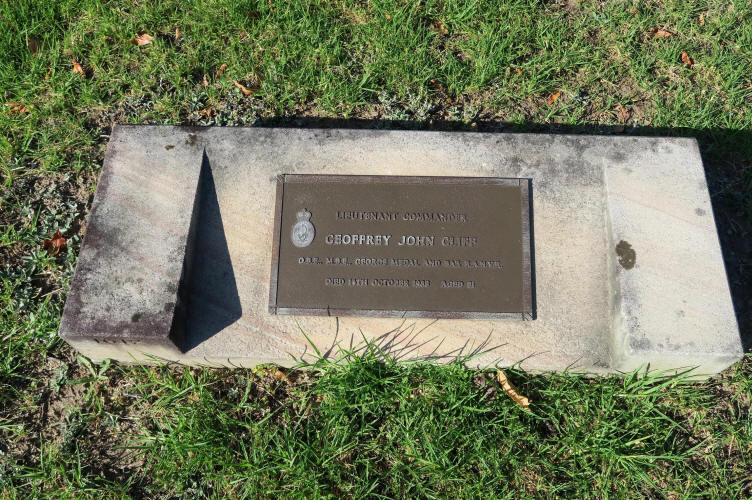LCDR Geoffrey John CLIFF OBE MBE GC & Bar
RANVR
 Geoffrey
John (Jack) Cliff (1907-1988), civil engineer and naval
officer, was born on 14 August 1907 at Beecroft, New South
Wales, son of Richard Charles Cliff, a Sydney-born engineer,
and his wife Adelaide Gertrude Orontes. Geoff became a civil
engineer, working for Coolah Shire Council in 1934-38 and
the Snowy River Shire in 1939-40. Geoffrey
John (Jack) Cliff (1907-1988), civil engineer and naval
officer, was born on 14 August 1907 at Beecroft, New South
Wales, son of Richard Charles Cliff, a Sydney-born engineer,
and his wife Adelaide Gertrude Orontes. Geoff became a civil
engineer, working for Coolah Shire Council in 1934-38 and
the Snowy River Shire in 1939-40.
On 1 January 1941 Cliff was appointed probationary
Sub-Lieutenant, Royal Australian Naval Volunteer Reserve,
under the Yachtsmen Scheme. He was then 5 ft 7½ ins (171 cm)
tall, with fair hair and blue eyes. Sent to England for
training at HMS King Alfred, he was promoted to provisional
Lieutenant in April and posted to the Admiralty’s Land
Incident Section, which disarmed and disposed of German
magnetic and acoustic mines dropped by parachute across the
British Isles. He used his engineering skills to defuse
mines that had penetrated deep below ground, thus earning
the nickname `Contractor Jack’. Peter Firkins described him
as slightly eccentric, a confirmed bachelor with a
remarkable capacity for drinking beer. He was a bright and
jovial man with a hearty laugh.
In May 1941 Cliff made his way through the debris of a
two-storey building at Bermondsey, London, to reach an
unexploded parachute mine. A nearby mine or bomb detonated,
nearly burying him in wreckage. Realising that the explosion
had probably started the clockwork fuse of the parachute
mine, he extricated himself and rendered it safe. On another
occasion he dealt with a mine buried in 24 ft (7.31 m) of
clay at Leysdown, Kent. This weapon was even more dangerous
than usual as it had been badly damaged in its fall and was
fitted with an anti-handling device operated by a
photoelectric cell. For his 'gallantry and undaunted
devotion to duty' in these and other operations, both on
land and under water, he was awarded the George Medal in
June 1942.
Recommendation for George Medal
 "On
11.5.1941 an unexploded parachute mine was reported as
having dropped on a two-storey building in the Leather
Market at Bermondsey. The mine was eventually found
completely covered by debris, and Lieutenant Cliff had to
make his way through and below this debris to reach it. When
he was about to commence operations another mine or bomb
detonated nearby, completely burying him in wreckage and
rubble. Lieutenant Cliff realised full well that this
detonation was more than liable to have started the
clockwork fuse in the mine with which he was dealing. With
the greatest difficulty he managed to escape from under the
debris by which he was buried, and immediately continued his
operations on the mine which he successfully rendered safe.
A further instance of the difficulties and onerous
conditions under which he was working is provided by the
fact that it was necessary to demolish the walls of the
building before the mine could be removed. "On
11.5.1941 an unexploded parachute mine was reported as
having dropped on a two-storey building in the Leather
Market at Bermondsey. The mine was eventually found
completely covered by debris, and Lieutenant Cliff had to
make his way through and below this debris to reach it. When
he was about to commence operations another mine or bomb
detonated nearby, completely burying him in wreckage and
rubble. Lieutenant Cliff realised full well that this
detonation was more than liable to have started the
clockwork fuse in the mine with which he was dealing. With
the greatest difficulty he managed to escape from under the
debris by which he was buried, and immediately continued his
operations on the mine which he successfully rendered safe.
A further instance of the difficulties and onerous
conditions under which he was working is provided by the
fact that it was necessary to demolish the walls of the
building before the mine could be removed.
On 2.7.1941, a "G" type Mine dropped at Leysdown, Isle of
Sheppey. "G" Type Mines are dropped without parachutes, and,
if they do not explode on impact, nearly always bury
themselves deep in the ground. Moreover they contain not
only a magnetic unit, which is presumed to be alive, but
also an anti-handling device operated by a photo-electric
cell. It is therefore necessary to work at the bottom of a
deep hole and in darkness. In this instance the mine was
badly damaged by its fall, making it even more dangerous,
and was buried 24 feet down in clay soil. Lieutenant Cliff
found that the clay had found its way under the cover of the
mine and had shorn off the top plate of the switch. In
consequence he worked on through a series of electric shocks
and sparks due to the damaged switch, not knowing whether
these were going to detonate the mine. He eventually removed
the damaged switch by sheering off the six screws which held
it. He then had to remove the bolts holding the magnetically
alive unit with a hacksaw owing to their damaged condition.
However, after nearly a month of hard and hazardous work he
succeeded in rendering the mine safe.
Between August to October, Lieutenant Cliff also
successfully dealt with three other mines in the Thames
Estuary District, which were endangering oil tanks at Thames
Haven. These mines were covered with water and mud and were
buried about 8 to 16 feet down. In each instance coffer dams
had to be erected and the water pumped out, and each took
between a fortnight and a month to recover. These mines were
particularly dangerous, as previous attempts had been made
to countermine them.
Lieutenant Cliff was assisted throughout by Lieutenant
Charles Graham Tanner, R.N.V.R. as "Learner", and the
excavating and timbering was done by Lieutenant Lombard and
22 B.D.S Group, Section 216, to whom the greatest credits
were due. In dealing with these incidents, Lieutenant Cliff
showed the highest qualities of courage, resource, and
devotion to duty'"
 Cliff won a Bar to his GM for defusing mines in Belfast at
the sewerage works and in the town reservoir in June 1942. Cliff won a Bar to his GM for defusing mines in Belfast at
the sewerage works and in the town reservoir in June 1942.
For 'great bravery and steadfast devotion to duty' in other
actions he was appointed MBE in September 1943. 'That month
he was promoted to acting Lieutenant Commander.
He was
elevated to OBE in April 1944 in 'recognition of his
contribution to mine disposal over four difficult and
dangerous years'.
In October he and his
colleague L. V. Goldsworthy were transferred to the Pacific
as liaison officers with the United States Navy’s Mobile
Explosives Investigation Unit No.1.
Cliff’s RANVR
appointment terminated on 29 January 1946. That year he
returned to London as a member of the Australian contingent
for the Victory March.
After the war Cliff resumed his career as a civil engineer
with various shires of New South Wales. In 1955-58 he was
the chief roads engineer for the British protectorate
Brunei, Borneo. A member of the Imperial Service Club,
Sydney, and the Dee Why sub-branch of the Returned Services
League of Australia, he enjoyed the company of friends at
the Collaroy Services Beach Club on Sunday mornings. He
listed golf as his recreation. In later years he was devoted
to his dogs and garden.
He died on 14 October 1988 at the
Repatriation General Hospital, Concord, and was buried in
the Field of Mars cemetery, Ryde, NSW.

Sources:
Australian Dictionary of Biography
Traces of War
|

